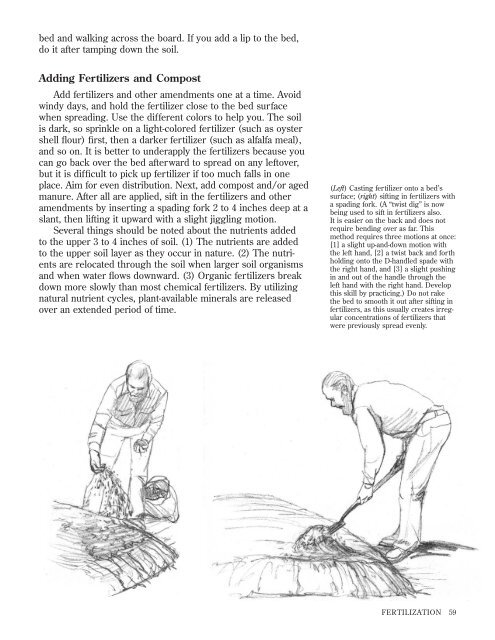How to Grow More Vegetables : And Fruits, Nuts ... - Shroomery
How to Grow More Vegetables : And Fruits, Nuts ... - Shroomery
How to Grow More Vegetables : And Fruits, Nuts ... - Shroomery
You also want an ePaper? Increase the reach of your titles
YUMPU automatically turns print PDFs into web optimized ePapers that Google loves.
ed and walking across the board. If you add a lip <strong>to</strong> the bed,<br />
do it after tamping down the soil.<br />
Adding Fertilizers and Compost<br />
Add fertilizers and other amendments one at a time. Avoid<br />
windy days, and hold the fertilizer close <strong>to</strong> the bed surface<br />
when spreading. Use the different colors <strong>to</strong> help you. The soil<br />
is dark, so sprinkle on a light-colored fertilizer (such as oyster<br />
shell flour) first, then a darker fertilizer (such as alfalfa meal),<br />
and so on. It is better <strong>to</strong> underapply the fertilizers because you<br />
can go back over the bed afterward <strong>to</strong> spread on any lef<strong>to</strong>ver,<br />
but it is difficult <strong>to</strong> pick up fertilizer if <strong>to</strong>o much falls in one<br />
place. Aim for even distribution. Next, add compost and/or aged<br />
manure. After all are applied, sift in the fertilizers and other<br />
amendments by inserting a spading fork 2 <strong>to</strong> 4 inches deep at a<br />
slant, then lifting it upward with a slight jiggling motion.<br />
Several things should be noted about the nutrients added<br />
<strong>to</strong> the upper 3 <strong>to</strong> 4 inches of soil. (1) The nutrients are added<br />
<strong>to</strong> the upper soil layer as they occur in nature. (2) The nutrients<br />
are relocated through the soil when larger soil organisms<br />
and when water flows downward. (3) Organic fertilizers break<br />
down more slowly than most chemical fertilizers. By utilizing<br />
natural nutrient cycles, plant-available minerals are released<br />
over an extended period of time.<br />
(Left) Casting fertilizer on<strong>to</strong> a bed’s<br />
surface; (right) sifting in fertilizers with<br />
a spading fork. (A “twist dig” is now<br />
being used <strong>to</strong> sift in fertilizers also.<br />
It is easier on the back and does not<br />
require bending over as far. This<br />
method requires three motions at once:<br />
[1] a slight up-and-down motion with<br />
the left hand, [2] a twist back and forth<br />
holding on<strong>to</strong> the D-handled spade with<br />
the right hand, and [3] a slight pushing<br />
in and out of the handle through the<br />
left hand with the right hand. Develop<br />
this skill by practicing.) Do not rake<br />
the bed <strong>to</strong> smooth it out after sifting in<br />
fertilizers, as this usually creates irregular<br />
concentrations of fertilizers that<br />
were previously spread evenly.<br />
FERTILIZATION 59












